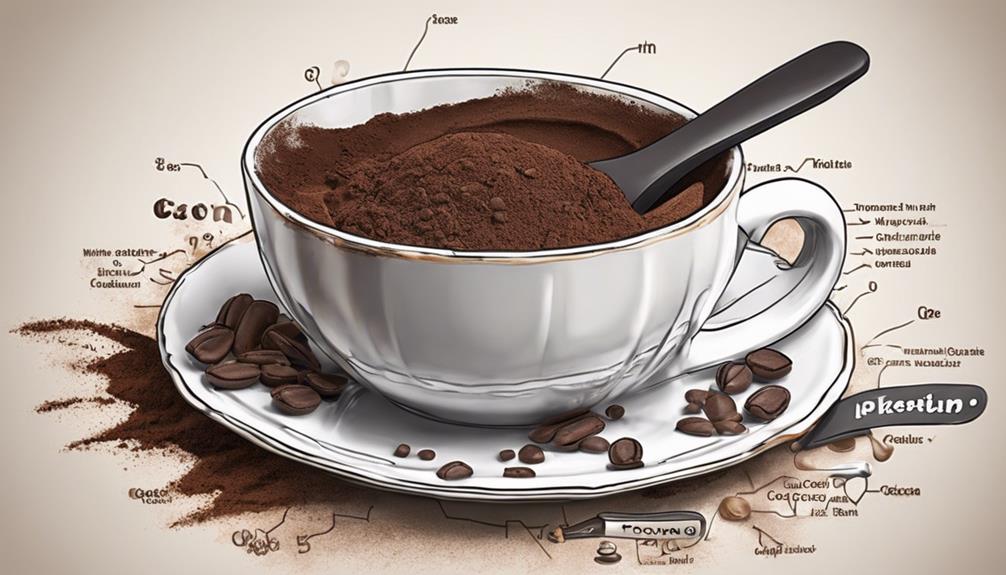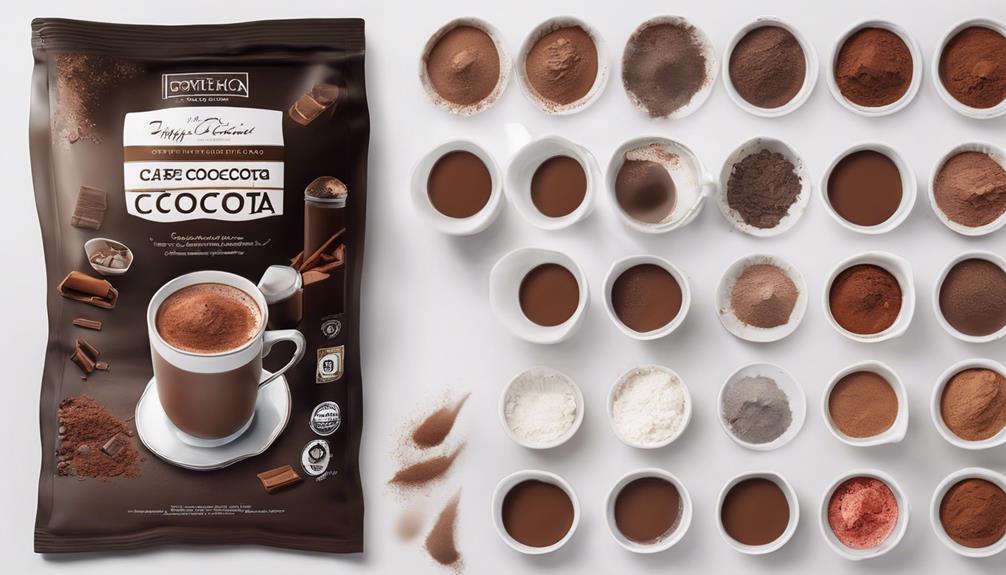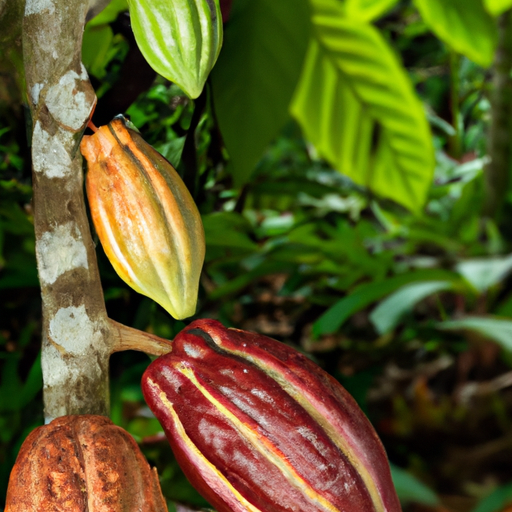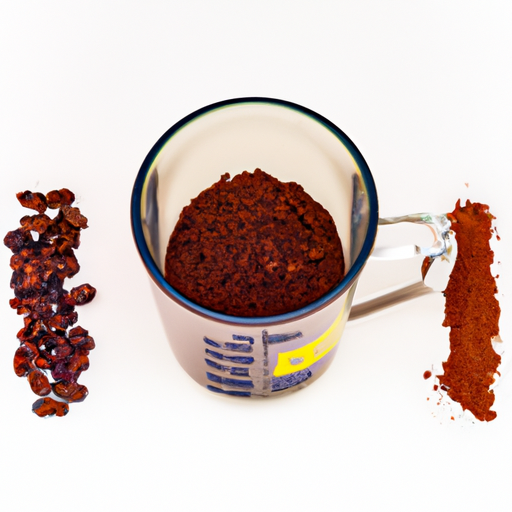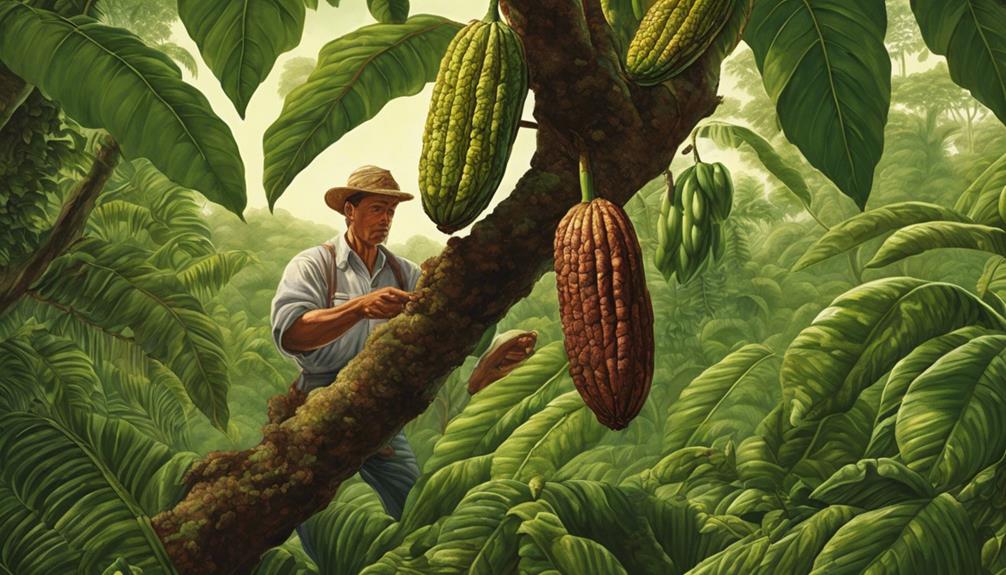I stumbled upon the fact that cocoa powder, which originates from the Olmec civilization in southern Mexico, contains approximately 12mg of caffeine per tablespoon, making it a milder option for boosting energy compared to coffee or tea. The process of producing cocoa powder involves fermentation, drying, roasting, and grinding to extract pure cocoa solids. Cocoa powder is not only low in calories and packed with antioxidants, but it also provides numerous health benefits, such as supporting heart health and enhancing cognitive function. If you are interested in these unexpected facts about cocoa powder, there is still much more to discover about its intriguing journey and application in different fields.
Key Takeaways
- Cocoa powder contains around 12mg of caffeine per tablespoon.
- It has lower caffeine levels compared to coffee and tea.
- The caffeine content can vary based on the brand and processing.
- Offers a mild energy boost without the jitters.
- Ideal for those seeking a gentle pick-me-up option.
History of Cocoa Powder
The discovery of cocoa powder traces back to the Olmec civilization in southern Mexico, where cacao fruit was first roasted. This marked the beginning of the fascinating history of cocoa powder. The Olmecs understood the potential of this fruit, not just for its rich flavor but also for its stimulating properties. They recognized the energizing effects of caffeine present in cocoa, which provided them with a natural boost.
As time passed, other Mesoamerican civilizations like the Mayans and Aztecs continued to embrace cocoa in various forms. They cherished a bitter concoction known as xocoatl, attributing mystical and healing properties to this precious bean.
When Christopher Columbus brought cocoa beans to Europe, he inadvertently set the stage for the global popularity of cocoa powder. The Europeans refined the processing methods, eventually leading to the creation of cocoa powder as it's understood today. This journey from ancient civilizations to modern times showcases the enduring appeal and significance of cocoa in our lives.
Cocoa Powder Production Process
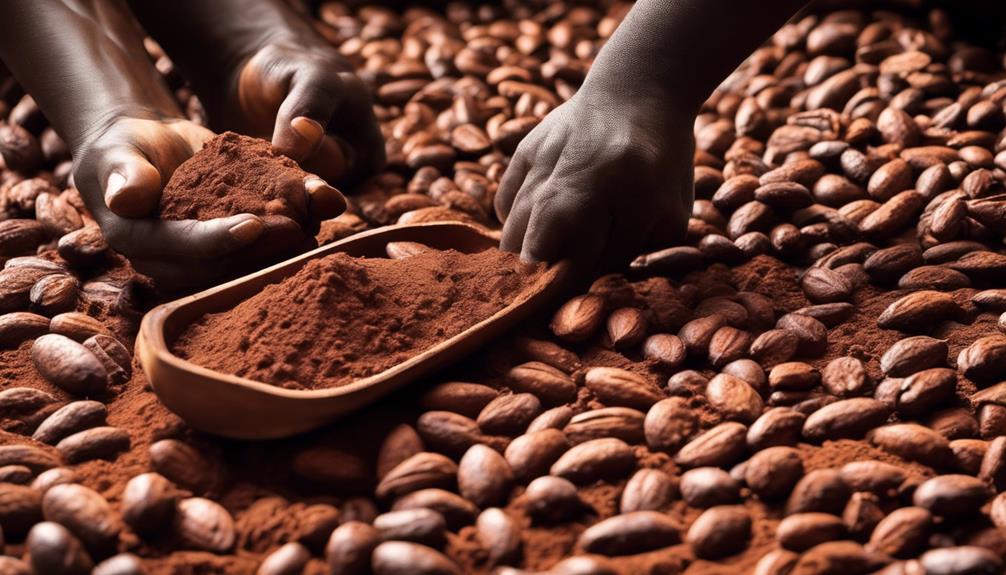
Exploring the intricate steps involved in transforming cocoa beans into the beloved cocoa powder reveals a fascinating journey of fermentation, drying, roasting, and grinding. The process of cocoa powder production is a delicate art that requires attention to detail and precision. Here is a glimpse into the intriguing process:
- Fermentation: Cocoa beans undergo a fermentation process where they're placed in heaps or containers to develop the flavor precursors essential for the rich taste of cocoa powder.
- Drying: After fermentation, the beans are dried to reduce moisture content, enhancing the intensity of the cocoa flavor before further processing.
- Roasting and Grinding: The dried beans are roasted to bring out the complex flavors and then ground into a fine powder. During grinding, cocoa butter is extracted, leaving behind the pure cocoa solids that make up cocoa powder.
Witnessing the transformation of cocoa beans into the velvety cocoa powder we adore highlights the skill and care involved in each step of the production process.
Cocoa Powder Nutrition Profile
Delving into the nutritional benefits of cocoa powder reveals a powerhouse of antioxidants and essential nutrients packed into a small serving size. Cocoa powder is not just about its rich chocolate flavor; it also offers a range of health benefits. A 10g serving of this delicious powder contains approximately 22 calories, 2.5g of carbohydrates, and 0.7g of fat. What makes cocoa powder truly impressive is its iron content, providing 4% of the daily value (DV) in just one serving. Iron is essential for energy production and overall well-being. Furthermore, cocoa powder is a fantastic source of antioxidants, which play a crucial role in preventing high blood pressure and supporting heart and brain health.
To highlight the nutritional content of cocoa powder, let's break down its key components in the table below:
| Nutrient | Amount per 10g Serving |
|---|---|
| Calories | 22 |
| Carbohydrates | 2.5g |
| Fat | 0.7g |
| Iron | 4% of DV |
Including cocoa powder in your diet is not only a delightful way to enjoy chocolate flavor but also a smart choice to boost your antioxidant intake and support your iron levels.
Caffeine Content in Cocoa Powder
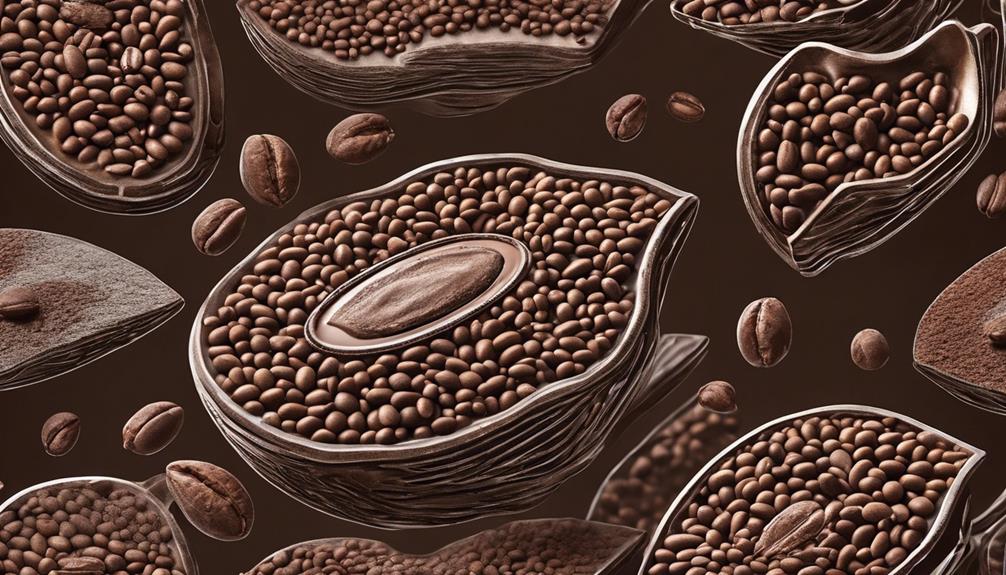
Moving from the nutritional profile of cocoa powder to its caffeine content, we find that cocoa powder contains approximately 12 milligrams of caffeine per tablespoon.
When considering the caffeine content in cocoa powder, it's crucial to recognize that:
- Lower than Coffee and Tea: Compared to coffee and tea, cocoa powder has a lower caffeine content, making it a suitable option for those looking to reduce their caffeine intake while still enjoying a hint of chocolatey goodness.
- Mild Energy Boost: The caffeine in cocoa powder can offer a mild energy boost, perfect for a midday pick-me-up without the jitters often associated with higher caffeine beverages.
- Variability in Caffeine Levels: The amount of caffeine in cocoa powder can vary depending on factors such as the brand and processing method used. Recognizing these variables is key when considering your overall caffeine intake throughout the day.
Enjoy the delightful taste of cocoa powder while managing your caffeine intake effectively!
Health Benefits of Cocoa Powder
Cocoa powder offers various health benefits due to its antioxidant properties, which can promote heart health and protect against certain diseases. These antioxidants found in cocoa powder help combat free radicals in the body, potentially reducing the risk of heart conditions.
Including cocoa powder in your diet can be a tasty way to boost your health and well-being.
Heart Health Benefits
Rich in antioxidants and beneficial compounds, cocoa powder offers significant heart health benefits by reducing inflammation, improving blood vessel function, and lowering the risk of cardiovascular diseases. When it comes to heart health, cocoa powder is an important ally. Here are three ways cocoa powder can benefit your heart:
- Reducing Inflammation: The antioxidants in cocoa powder help combat inflammation in the body, which is linked to heart diseases.
- Improving Blood Vessel Function: Cocoa powder's flavonoids play a vital role in enhancing blood vessel function, promoting better circulation and potentially reducing blood pressure.
- Lowering Cardiovascular Risk: Regular consumption of cocoa powder has been associated with decreased levels of LDL cholesterol, which is a key factor in reducing the risk of heart disease.
Antioxidant Properties
With its abundance of antioxidants, cocoa powder offers a myriad of health benefits, including protection against cell damage and inflammation. The essential properties found in cocoa powder not only safeguard cells but also combat inflammation, potentially reducing the risk of chronic diseases.
These antioxidants play a vital role in promoting heart health by decreasing oxidative stress and inflammation, which are key factors in heart disease. Additionally, the antioxidants in cocoa powder can enhance brain health by boosting cognitive function and shielding against neurodegenerative conditions.
Potential Side Effects of Cocoa Powder
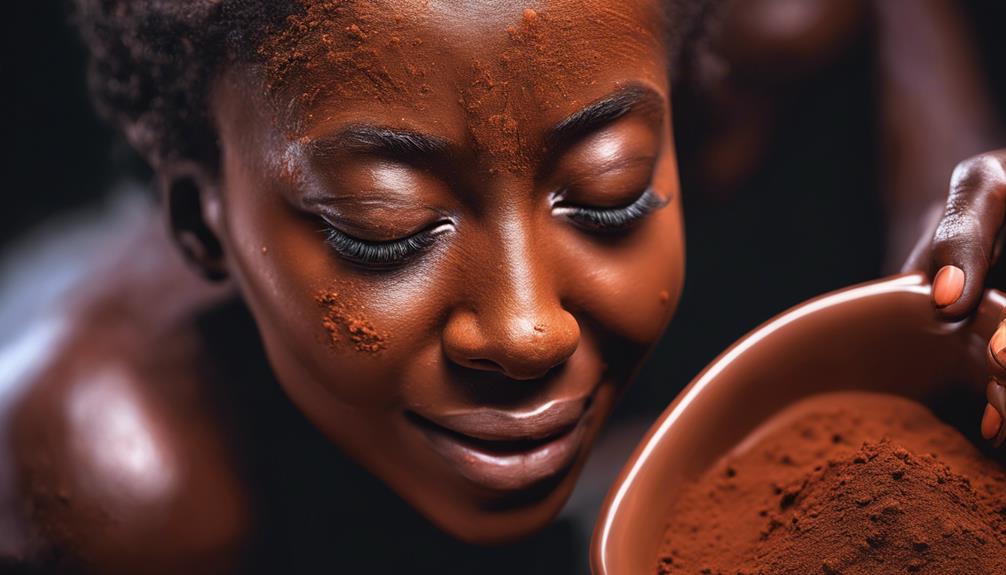
Experiencing potential side effects from consuming cocoa powder is an important aspect to ponder for individuals aiming to maintain their well-being. Here are some essential considerations:
- Insomnia and Digestive Issues: Consuming cocoa powder in excess can disrupt sleep patterns and lead to stomach discomfort. It's vital to consume it in moderation to avoid these uncomfortable side effects.
- Allergic Reactions and Migraines: Some individuals may experience allergic reactions or migraines after consuming cocoa powder. It's crucial to be aware of your body's response and adjust your intake accordingly to prevent these issues.
- Interactions with Medications: Cocoa powder can interact with certain medications, affecting their effectiveness. It's advisable to consult with a healthcare provider to understand how cocoa powder may interact with any medications you're taking.
Being mindful of these potential side effects will help you enjoy cocoa powder while prioritizing your health.
Culinary Uses of Cocoa Powder
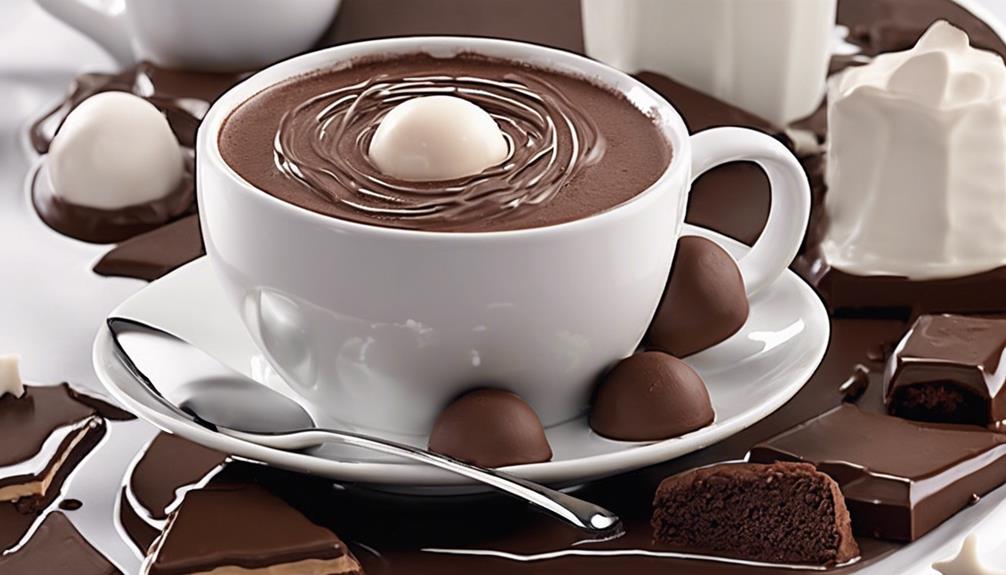
When it comes to culinary uses, cocoa powder can elevate your dishes in various ways.
From baking decadent cakes to whipping up savory cocoa-infused sauces, the possibilities are endless.
Incorporating cocoa powder into your recipes not only enhances the flavor but also adds a delightful touch of chocolate goodness.
Baking With Cocoa
Baking recipes benefit greatly from the inclusion of cocoa powder due to its ability to enhance the depth and richness of desserts with its intense chocolate flavor. When baking with cocoa powder, consider these essential tips to elevate your sweet treats:
- Sift with Dry Ingredients: For a smooth batter, sift cocoa powder along with the dry ingredients like flour and baking powder.
- Mix with Wet Ingredients: Alternatively, blend cocoa powder with wet ingredients such as eggs and milk to guarantee even distribution and a luscious texture.
- Use the Right Type: Follow the recipe's guidance on the type of cocoa powder to use, whether Dutch-Process or Natural, to achieve the best results in your chocolatey creations.
Cocoa in Desserts
Indulging in desserts enriched with cocoa powder heightens the decadent chocolate experience with every bite. The versatile cocoa powder adds a vital, intense chocolate flavor to a variety of desserts like cakes, brownies, cookies, and truffles.
Its deep, dark color not only enhances the taste but also gives baked goods an appealing look. Whether in traditional recipes or modern creations, cocoa powder brings a touch of indispensability to sweet treats.
It plays a pivotal role in making chocolate frosting, mousse, pudding, and ice cream, taking the dessert experience to a whole new level. By incorporating cocoa powder into dessert recipes, you can create indulgent treats that are adored by chocolate enthusiasts for their rich, satisfying taste.
Savory Cocoa Dishes
Cocoa powder's versatility extends beyond sweet treats, finding its place in savory dishes like chili, mole sauce, and dry rubs for meats to impart depth and richness.
- Imagine a hearty bowl of chili with a hint of cocoa powder, adding a unique depth to the savory flavors.
- Picture a succulent piece of meat coated in a cocoa-infused dry rub, creating a caramelized crust bursting with umami qualities.
- Visualize a velvety mole sauce where cocoa powder harmonizes with spices, creating a complex and satisfying taste experience.
These savory dishes showcase how cocoa powder's umami qualities can elevate traditional recipes, offering a delightful balance of flavors that will leave your taste buds craving more.
Cocoa Powder in Beauty Products
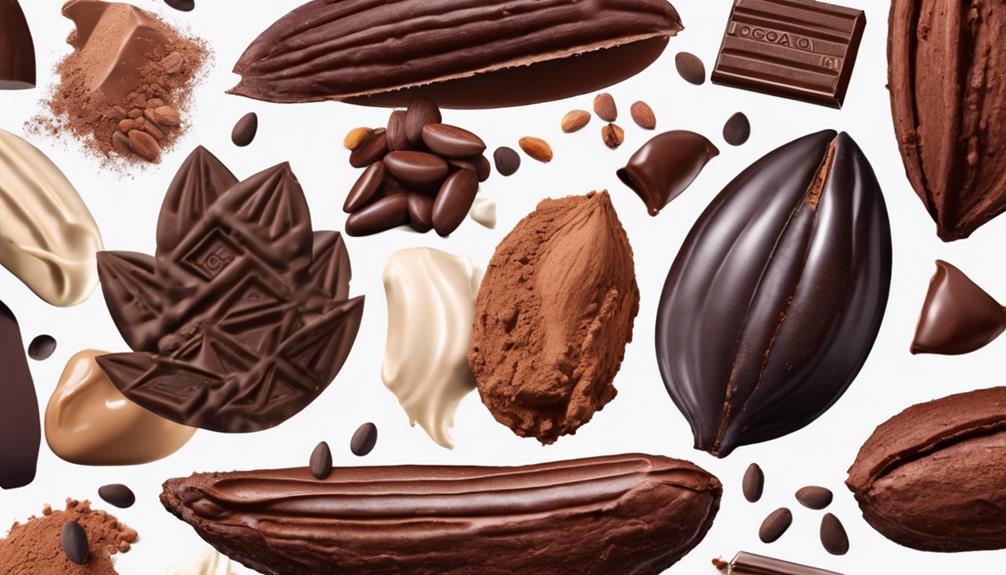
With its renowned moisturizing and antioxidant properties, cocoa butter extracted from cocoa beans has become a staple ingredient in various beauty products. Cocoa powder, a key component in these formulations, offers a range of benefits for skin rejuvenation. Let's explore the world of cocoa powder in beauty products through the table below:
| Benefits of Cocoa Powder in Beauty Products |
|---|
| Moisturizing and emollient properties |
| Antioxidant content for skin protection |
| Improved blood circulation for skin rejuvenation |
| Rich in vitamins and minerals for nourishing the skin |
Cocoa-based beauty products such as body butters, creams, and masks are not only known for their luxurious textures but also for their delightful chocolate scent. When considering skincare formulations, the inclusion of cocoa powder can help in maintaining healthy, radiant skin. Next time you reach for a beauty product, check if it contains cocoa powder for a touch of natural goodness.
Environmental Impact of Cocoa Production

Cocoa production has a significant impact on the environment, contributing to deforestation and water pollution. The use of pesticides and fertilizers in cocoa farming can harm the soil and nearby water sources.
Sustainable practices, like shade-grown cocoa and fair trade certifications, aim to minimize these negative effects.
Cocoa Farming Practices
Having observed firsthand the environmental impact of cocoa farming practices, it's evident that deforestation for cocoa plantations poses a significant challenge to ecosystem preservation.
- The lush green forests are cleared to make way for vast cocoa plantations, disrupting the natural habitats of countless species.
- The once vibrant ecosystems are replaced with rows of cocoa trees, leading to a loss of biodiversity and a decline in wildlife populations.
- Rivers and streams that once flowed freely through the forests are now at risk of pollution due to the increased use of chemicals in cocoa farming.
These practices highlight the importance of shifting towards sustainable cocoa farming methods to protect our environment for future generations.
Sustainability Efforts
Observing the environmental impact of cocoa farming practices firsthand, it becomes evident that sustainable efforts are essential in preserving ecosystems for future generations. Cocoa production often leads to deforestation, causing habitat loss for wildlife. Sustainable farming practices, such as maintaining biodiversity and reducing chemical use, are vital in mitigating these effects.
Certification programs like Fair Trade and Rainforest Alliance play a significant role in promoting sustainable cocoa production by ensuring ethical and environmentally friendly practices are followed. Additionally, cocoa farming contributes to climate change through deforestation, but methods like agroforestry can help lessen these impacts.
The cocoa industry is actively working towards greater sustainability by addressing issues like child labor, fair wages, and implementing environmentally friendly practices.
Future Trends in Cocoa Powder Consumption

With the increasing focus on sustainability and health-conscious choices, the future trends in cocoa powder consumption are set to revolutionize the industry.
- Organic and Fair Trade: More consumers are gravitating towards ethically sourced cocoa powder, ensuring that their consumption aligns with their values of supporting sustainable and fair practices in the industry.
- Health Benefits: The rising awareness of the various health benefits of cocoa powder, such as its antioxidant properties and potential to improve heart health, is driving its increased consumption across different demographics.
- Diverse Applications: Cocoa powder is no longer limited to baking; its versatility in beverages, desserts, and even savory dishes is expanding, offering consumers innovative ways to incorporate this beloved ingredient into their daily lives.
These trends signify a shift towards a more conscientious and diverse approach to cocoa powder consumption, where quality, ethics, and health considerations play pivotal roles in shaping the industry's future landscape.
Frequently Asked Questions
What Are Some Interesting Facts About Cocoa Powder?
Cocoa powder, a delightful ingredient, holds intriguing facts. It's a chocolatey gem with minimal caffeine, versatile in baking. Rich in antioxidants and minerals like iron and magnesium, it offers a healthier chocolate fix.
What Are 5 Interesting Facts About Hot Cocoa?
Hot cocoa, a comforting drink enjoyed worldwide, has a rich history. From its origins as a bitter brew to its presence in rations during wartime, its cultural significance and versatility make it a beloved treat.
Can Caffeine Be Found in Cocoa?
Yes, caffeine can be found in cocoa. It contains around 12 mg per tablespoon on average. Dark chocolate made from cocoa powder has more caffeine than milk chocolate. It gives a gentle energy boost without jitters.
What Are 2 Facts About Cocoa?
Cocoa powder is a versatile ingredient with rich flavor profiles. It's packed with antioxidants and minerals beneficial to health. Different fat content options cater to diverse culinary needs. Its versatility and health benefits make it a kitchen staple.
Are There Any Hidden Benefits of Cocoa Powder Caffeine That I Should Know About?
Yes, there is the truth about cocoa caffeine is that it contains various beneficial compounds besides just caffeine. Cocoa powder is rich in antioxidants, which can help to improve heart health and lower inflammation. Additionally, it contains theobromine, which has been linked to improved mood and cognitive function.
Conclusion
As we explore the world of cocoa powder, we uncover a treasure trove of surprises. From its rich history to its versatile culinary uses, cocoa powder is truly a powerhouse ingredient.
Remember, just like cocoa powder adds depth and flavor to recipes, it also contains caffeine to give you that extra boost.
So next time you enjoy a delicious chocolate treat, think about the fascinating journey of cocoa powder from bean to cup.

